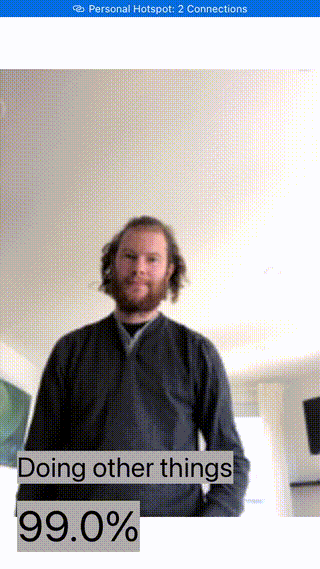State-of-the-art Real-time Action Recognition for iOS
Website • Blogpost • Getting Started • Deploy Your Own Classifier • Datasets • SDK License
This repository contains the iOS version of sense which allows you to build an iOS demo app running the pytorch models after converting them to CoreML using the provided script.
You can convert and deploy the existing gesture detection model as is, or, use the transfer learning script in sense to train on your own custom classification outputs on top of it. More models will be supported soon.
The model uses an efficientnet backbone and was confirmed to run smoothly on iOS devices with A11 chips (e.g. iPhone 8 or higher) and may also work on devices with A10 chips (e.g. iPad 6/7, iPhone 7).
The following steps will help you install the necessary components to get up and running in no time with your project.
To begin, clone this repository, as well as sense, to a local directory of your choice:
git clone https://github.com/TwentyBN/sense-iOS.gitYou will also need to clone sense (we will use it to convert Pytorch models to CoreML):
git clone https://github.com/TwentyBN/sense.git
cd senseNext, follow the instructions for sense to install its dependencies.
You will need to download our pre-trained models to build the demo application. Once again, please follow the instructions in sense to access them (you will have to create an account and agree to our terms and conditions).
This project relies on Pods to install Tensorflow Lite.
If you don't have cocoapods installed on your mac, you can install it using brew:
brew install cocoapodsYou then need to install the pods by running the following command line:
# If you are in sense-iOS root directory:
pod installThis section will explain how you can deploy our pre-trained models, or your own custom model, to an iOS application.
The iOS demo requires a Tensorflow Lite version of our model checkpoint which you can produce using the script provided in
sense which, for our pre-trained gesture control model, can be run using:
python tools/conversion/convert_to_tflite.py --backbone=efficientnet --classifier=efficient_net_gesture_control --output_name=modelYou should now have the following Tensorflow Lite file: sense/resources/model_conversion/model.tflite.
The Tensorflow Lite file created in the last step can be moved from sense to sense-iOS in the following location: sense-iOS/sense-iOS/model.tflite
# If you are in sense
mv ./resources/model_conversion/model.tflite ../sense-iOS/sense-iOS/model.tfliteYou can now open the iOS project with Xcode and build it to your device. Have fun!
Using our transfer learning script, it is possible to further fine-tune our model to your own classification tasks. If you do so, you'll have to reflect the new outputs in various files in the iOS project:
By default, the dictionary in sensenet_labels.json contains the labels our model was trained on for the gesture control task. Replace these with the contents of the label2int.json file produced during training.
We now have a blogpost you can cite:
@misc{sense2020blogpost,
author = {Guillaume Berger and Antoine Mercier and Florian Letsch and Cornelius Boehm and
Sunny Panchal and Nahua Kang and Mark Todorovich and Ingo Bax and Roland Memisevic},
title = {Towards situated visual AI via end-to-end learning on video clips},
howpublished = {\url{https://medium.com/twentybn/towards-situated-visual-ai-via-end-to-end-learning-on-video-clips-2832bd9d519f}},
note = {online; accessed 23 October 2020},
year=2020,
}The code is copyright (c) 2020 Twenty Billion Neurons GmbH under an MIT Licence. See the file LICENSE for details. Note that this license only covers the source code of this repo. Pre-trained weights come with a separate license available here.




